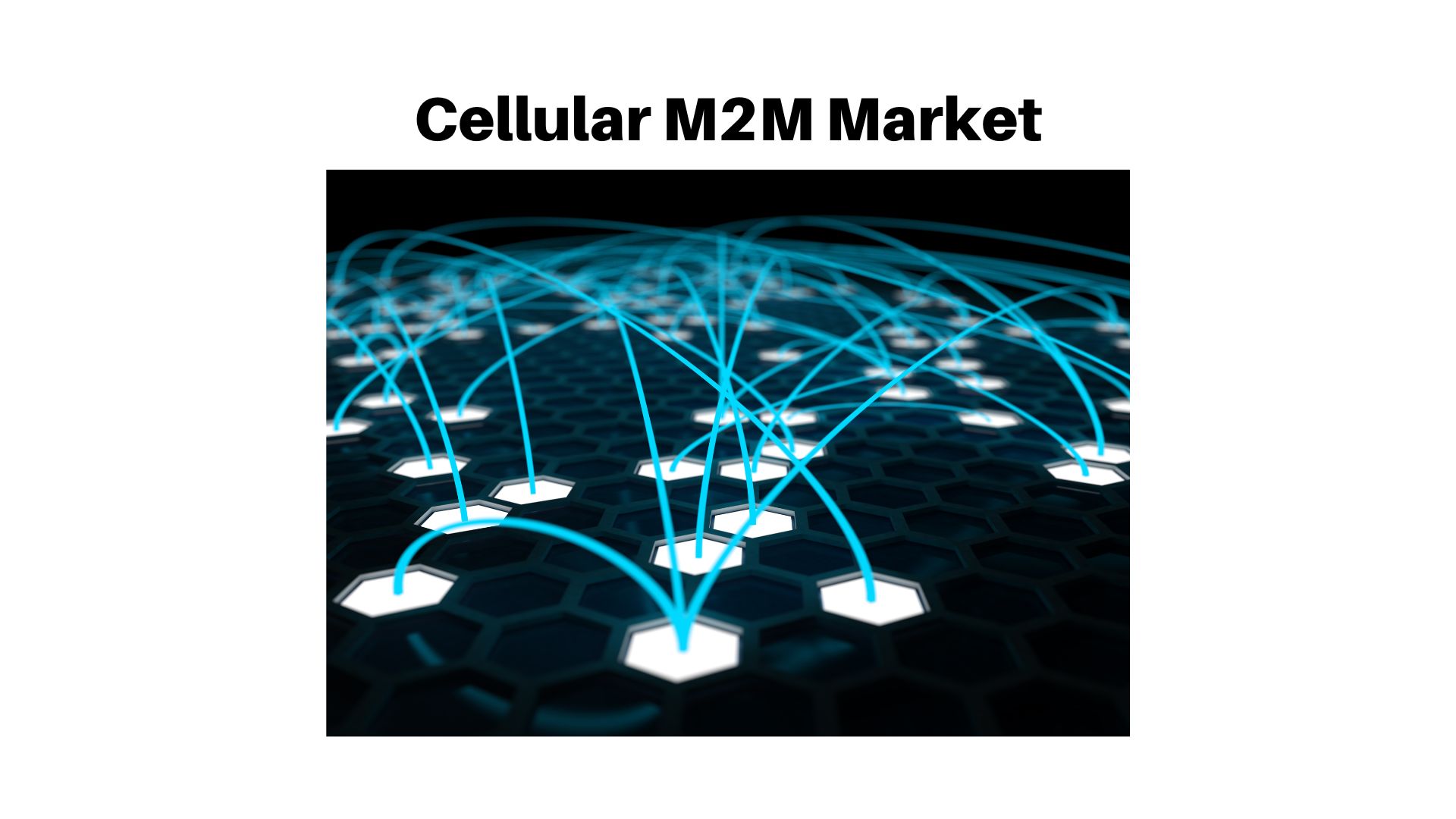Cellular M2M Market Will Reach Size Of USD 92.73 Bn By 2033 | CAGR: 20.4%

Page Contents
Market Overview
Published Via 11Press: Cellular M2M Market is the capability for devices to exchange data and perform tasks with one another autonomously over cellular networks. This technology enables machines to exchange information without human intervention, leading to more efficient processes in industries such as manufacturing, transportation, healthcare, and agriculture. Cellular M2M relies on 3G, 4G, and 5G networks for transmitting data between devices; devices may be equipped with modems or embedded SIMs which provide connectivity over these cellular networks.
The Cellular M2M Market size is expected to reach USD 92.73 Bn by 2033, up from its current value of USD 12.03 Bn in 2022, growing at an annual compound growth rate (CAGR) of 20.4% from 2023-2033.
Common Examples
- Asset tracking: Utilizing GPS and cellular technology to monitor the location of vehicles, cargo, or other assets in real-time.
- Industrial automation: Integrating sensors, machines, and other devices to monitor and control industrial processes.
- Smart cities: Utilizing cellular-connected devices to collect data on traffic patterns, air quality and other factors for improving urban infrastructure and services.
- Remote Monitoring: Connecting medical devices, environmental sensors, and other equipment to collect and transmit data for remote monitoring and diagnosis.
- Cellular M2M communication holds the potential to revolutionize many industries by enabling more efficient and automated processes, improved asset tracking, and superior data collection and analysis.
Key Takeaways
- Cellular M2M communication allows machines to exchange data without human intervention, creating more efficient and automated processes in industries such as manufacturing, transportation, healthcare, and agriculture.
- Cellular networks such as 3G , 4G and 5G provide connectivity between devices. Devices may be equipped with cellular modems or embedded SIMs which enable access to the cellular network.
- Cellular M2M communication has many applications, such as asset tracking, industrial automation, smart cities and remote monitoring.
- Cellular M2M technology holds the potential to revolutionize many industries by facilitating more efficient and automated processes, improved asset tracking, and superior data collection and analysis.
- However, cellular M2M communication also presents some difficulties, such as the need for extensive network coverage, security risks and the cost of connectivity and devices.
- As technology develops, we can expect to see more creative applications of cellular M2M communication and increased adoption across various industries.
Request For Sample Report Here: https://marketresearch.biz/report/cellular-m2m-market/request-sample/
Regional Snapshot
- North America: North America is one of the biggest markets for cellular M2M communication, with high levels of adoption across industries such as transportation, healthcare and energy. Furthermore, it boasts many leading cellular network providers and technology firms that are driving innovation and advancement within this space.
- Europe: Europe has emerged as a significant market for cellular M2M communication, with applications such as industrial automation, smart cities and environmental monitoring being particularly prominent. Furthermore, the European Union has actively promoted this development through policies and initiatives.
- Asia-Pacific: The Asia-Pacific region is seeing a meteoric rise in cellular M2M communication, spurred on by the increasing adoption of connected devices and expansion into industries such as manufacturing, logistics, and healthcare. China stands as one of the biggest markets within this region with significant investment in M2M technology.
- Latin America: Latin America has experienced an explosive growth in cellular M2M communication, particularly within sectors such as transportation and energy. Unfortunately, there are still limitations due to limited network coverage and expensive devices and connectivity.
- Middle East and Africa: The Middle East and Africa are rapidly developing markets for cellular M2M communication, with an emphasis on applications such as smart cities and agriculture. Unfortunately, the region also faces difficulties such as political instability and limited infrastructure.
Inquire Here & Query for report: https://marketresearch.biz/report/cellular-m2m-market/#inquiry
Drivers
The rising adoption of connected devices, such as sensors, wearables, and smart devices, is driving the demand for cellular M2M communication. These gadgets rely on cellular networks to transmit data and connect with other devices, opening up a world of applications and use cases.
- Improved network coverage and bandwidth: High-speed cellular networks such as 4G and 5G offer faster and more dependable M2M communication, especially for applications that require real-time data transmission with low latency.
- Advancements in Technology: The development of advanced cellular technologies, such as embedded SIMs, low-power wide-area (LPWA) networks and edge computing, is expanding the capabilities of cellular M2M communication and opening up new use cases.
- Industry Applications: Cellular M2M communication is seeing a surge of adoption in industries such as healthcare, transportation, logistics and manufacturing – leading to greater efficiency, automation and cost savings.
- Regulatory Support: Governments and regulatory organizations are actively encouraging the growth of cellular M2M communication through policies, initiatives, such as spectrum allocation, standardization, and funding programs.
- Cost Savings: With the decline in cost of cellular connectivity and devices, combined with an uptick in M2M communication demand, M2M communication is becoming more accessible and cost-effective for businesses of all sizes.
Restraints
- Network Coverage Limitations: Cellular M2M communication can face major difficulties due to network coverage limitations, particularly in remote and rural areas. When data transmission is poor or unreliable in these regions, it becomes difficult to deploy M2M applications effectively.
- Security Concerns: Cellular M2M communication relies on the transmission and storage of sensitive data that could be vulnerable to cyberattacks and breaches. This poses particular risks for applications in industries such as healthcare and finance, where data security is paramount.
- Cost of connectivity and devices: Although the cost of cellular connectivity and devices has decreased in recent years, it can still be a substantial obstacle for businesses looking to implement M2M communication, especially small and medium-sized enterprises.
- Interoperability and Standardization: Lacking standardization between various M2M devices and platforms can make it challenging to integrate and scale M2M applications.
- Regulatory Obstacles: Deploying M2M applications can be subject to regulatory issues, such as licensing requirements and spectrum allocation. This can cause delays and additional expenses for businesses looking to implement M2M solutions.
Opportunities
- Industry-Specific Applications: Cellular M2M communication has numerous industry-specific applications, such as smart cities, industrial automation, healthcare and logistics. These initiatives can increase efficiency, productivity and cost savings for businesses while also improving individuals' quality of life.
- Integration of M2M communication with the Internet of Things (IoT): Combining M2M communication with the IoT can open up new opportunities and applications, such as real-time monitoring, predictive maintenance, and intelligent decision-making.
- Emerging Technologies: New technologies such as 5G, LPWA networks and edge computing can enhance cellular M2M communication capabilities and open up new use cases like autonomous vehicles and drones.
- Data Analytics and Insights: The vast amount of data generated by M2M devices and applications can be analyzed to gain insight and make data-driven decisions. Doing so increases efficiency, reduces costs, and enhances overall performance for businesses.
- International Expansion: Cellular M2M communication can enable businesses to expand their operations and access new markets globally, particularly in developing regions where there is an increasing demand for connected devices and IoT applications.
Challenges
- Network Coverage: One of the biggest obstacles for cellular M2M communication is ensuring reliable network coverage, particularly in remote or rural areas. Poor network coverage can negatively affect data transmission quality and cause delays or interruptions in M2M applications.
- Interoperability: Lack of interoperability between different M2M devices and platforms can make it challenging to integrate and scale M2M applications. This creates siloed data, restricting our ability to gain insights and make data-driven decisions.
- Security: M2M communication relies on the transmission and storage of sensitive data that can be vulnerable to cyberattacks or breaches. Ensuring the security and privacy of M2M data is essential for safeguarding its integrity in applications while preventing unauthorized access.
- Standards and Regulations: The absence of standard protocols and regulations for M2M communication poses challenges to businesses wishing to deploy these applications across different regions or countries, potentially leading to additional costs and delays in the deployment of solutions.
- Cost: For businesses interested in adopting M2M communication, the cost of cellular connectivity and M2M devices can be a substantial barrier to entry. This poses particular difficulties for small and medium-sized enterprises (SMEs). Thus, scaling up or adopting M2M applications may be limited due to these expenses.
Market Segmentation
Vertical
- banking & financial services
- utilities
- transport & logistics
- security
- healthcare
- automotive
- networking
Module
- WiMAX and LTE
- GPRS
- UMTS/HSPA
- EDGE
- CDMA2000 modules
Key Players
- Vodafone Group PLC.
- Aeris Communications
- Sierra Wireless
- Verizon Communication Inc.
- Amdocs Inc.
- China Mobile Limited
- AT&T Inc.
- Sprint Corporation
- Telefnica S.A.
- Deutsche Telekom AG.
Report Scope
| Report Attribute | Details |
| Market size value in 2022 | USD 12.03 Bn |
| Revenue forecast by 2033 | USD 92.73 Bn |
| Growth Rate | CAGR Of 20.4% |
| Regions Covered | North America, Europe, Asia Pacific, Latin America, and Middle East & Africa, and Rest of the World |
| Historical Years | 2017-2022 |
| Base Year | 2022 |
| Estimated Year | 2023 |
| Short-Term Projection Year | 2028 |
| Long-Term Projected Year | 2033 |
Growing Demand => Request for Customization
Recent Developments
- 5G: The advent of 5G networks promises to revolutionize M2M communication, offering faster data speeds, lower latency, and greater connectivity for M2M devices. This opens up new use cases and applications such as autonomous vehicles and smart cities.
- LPWA networks: Low-power wide-area (LPWA) networks such as NB-IoT and LTE-M have emerged as an alternative to traditional cellular networks for M2M communication. These networks provide low-cost, low-power connectivity for devices connected to the internet of things (M2T), opening up new use cases and applications in industries like agriculture or logistics.
- Edge Computing: Edge computing is becoming more and more popular as a way to reduce latency and enhance processing power for M2M applications. By processing data closer to its source, edge computing enables real-time decision-making and reduces data transmitted over cellular networks.
- Blockchain Technology: Blockchain technology is being explored as a means to enhance security and privacy in M2M communication. By providing an uncentralized, tamper-proof ledger for M2M data, blockchain can help prevent unauthorized access and guarantee the integrity of M2M applications.
- Integration with AI and ML: Combining M2M communication with artificial intelligence (AI) and machine learning (ML) can open up new use cases and applications, such as predictive maintenance and intelligent decision-making. By analyzing large amounts of data generated by M2M devices, AI and ML help businesses gain insights and make data-driven decisions.
Key Questions
Q: What is Cellular M2M Communication?
Cellular M2M communication refers to the use of cellular networks for data exchange between devices and machines, enabling them to work together autonomously. Cellular networks allow these machines and devices to exchange information without human intervention or supervision.
Q: What are some examples of cellular M2M applications?
A: Examples include smart cities, industrial automation, healthcare and logistics. These solutions can lead to greater efficiency, productivity and cost savings for businesses while also improving individual quality of life.
Q: What are some of the advantages of cellular M2M communication?
A: Cellular M2M communication offers businesses greater efficiency, productivity and cost savings, as well as improved quality of life for individuals. Cellular M2M technology enables real-time monitoring, predictive maintenance and intelligent decision-making.
Q: What are some of the challenges associated with cellular M2M communication?
A: Some of the primary difficulties for mobile M2M communications involve network coverage, interoperability, security, standards and regulations as well as cost. Ensuring reliable connectivity for M2M devices can be a significant headache for businesses.
Q: What are some recent advances in cellular M2M communication?
A: Recent advancements in this space include 5G networks, LPWA networks, edge computing technology, blockchain exploration and M2M communication integration with AI/ML. All of these initiatives will create new use cases and applications for this form of connectivity.
Contact us
Contact Person: Mr. Lawrence John
Marketresearch.Biz (Powered By Prudour Pvt. Ltd.)
Tel: +1 (347) 796-4335
Send Email: [email protected]
The team behind market.us, marketresearch.biz, market.biz and more. Our purpose is to keep our customers ahead of the game with regard to the markets. They may fluctuate up or down, but we will help you to stay ahead of the curve in these market fluctuations. Our consistent growth and ability to deliver in-depth analyses and market insight has engaged genuine market players. They have faith in us to offer the data and information they require to make balanced and decisive marketing decisions.



